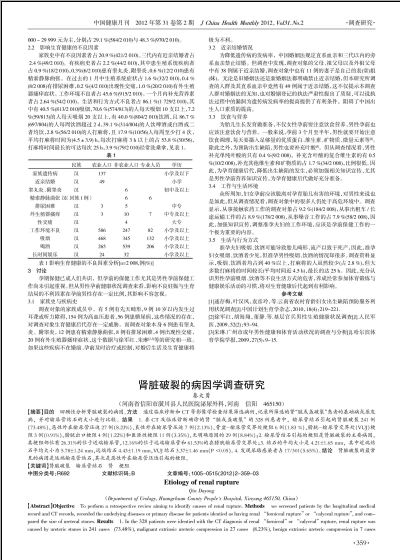肾脏破裂的病因学调查研究(1)
 |
| 第1页 |
参见附件(3985KB,3页)。
【摘要】目的 回顾性分析肾脏破裂的病因。方法 通过临床诊断和CT等影像学检查结果筛选病例,记录所筛选的肾“脏或盏破裂”患者的基础病或原发病,并对输尿管结石的大小进行比较。结果 1. 在CT及临床诊断确诊的肾“脏或盏破裂” 的328例患者中,输尿管结石引起的肾脏破裂241例(73.48%),恶性外在输尿管压迫27例(8.23%),良性外在输尿管压迫7例(2.13%),骨盆-输尿管交界处梗阻6例(1.83 %),膀胱-输尿管交界处(VUJ)梗阻3例(0.91%),膀胱出口梗阻4例(1.22%)和医源性梗阻11例(3.35%),无明确原因的29例(8.84%);2. 输尿管结石引起的梗阻是肾脏破裂的主要病因,其梗阻部位有26.31%的位于近端输尿管,12.16%的位于远端输尿管和61.53%的在膀胱输尿管交界处;3. 结石的平均大小是4.21±1.65 mm,其中近端结石平均大小为5.78±1.24 mm,远端结石4.43±1.19 mm,VUJ结石3.37±1.46 mm(P <0.05)。4. 发现尿路感染者占17/301(5.65%)。结论 肾脏破裂的最常见的病因是远端输尿管结石,其次是恶性外在输尿管压迫引起的梗阻。
【关键词】肾脏破裂 输尿管结石 肾 梗阻
中图分类号:R692 文献标识码:B 文章编号:1005-0515(2012)2-359-03
Etiology of renal rupture
Qin Dayong
(Department of Urology, Huangchuan County People's Hospital, Xinyang 465150, China)
【Abstract】Objective To perform a retrospective review aiming to identify causes of renal rupture. Methods we screened patients by the longitudinal medical record and CT records, recorded the underlying diseases or primary disease for patients identied as having renal “forniceal rupture” or “calyceal rupture”, and compared the size of ureteral stones. Results 1. In the 328 patients were identied with the CT diagnosis of renal “forniceal” or “calyceal” rupture, renal rupture was caused by ureteric stones in 241 cases (73.48%), m alignant extrinsic ureteric compression in 27 cases (8.23%), benign extrinsic ureteric compression in 7 cases (2.13%), pelvicureteric junction obstruction in 6 cases (1.83%), vesicoureteric junction (VUJ) obstruction in 3 case (0.91%), bladder outlet obstruction in 4 case (1.22%) and iatrogenic causes in 11 cases (3.35%),no denitive cause was found in 29 cases (8.84%). 2. For patients in whom a ureteric stone was the cause of renal rupture, the level of obstruction was proximal ureter in 26.31% of cases, distal ureter in 12.16% of cases and VUJ in 61.53% of cases. 3. Mean (SD) stone size was 4.21±1.65 mm, of which mean (SD) stone size was 5.78±1.24 mm for proximal stones, 4.43±1.19 mm for distal stones and 3.37±1.46 mm for VUJ stones (P <0.05). 4. Urinary tract infection was present in 17 out of 301 patients (5 ......
您现在查看是摘要介绍页,详见PDF附件(3985KB,3页)。